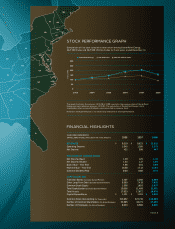CenterPoint Energy 2008 Annual Report Download - page 8
Download and view the complete annual report
Please find page 8 of the 2008 CenterPoint Energy annual report below. You can navigate through the pages in the report by either clicking on the pages listed below, or by using the keyword search tool below to find specific information within the annual report.
Our natural gas distribution business
had a good year with operating income of
$215 million, a decline of only $3 million
from the previous year’s record high of
$218 million. Economic conditions, energy
conservation and reduced usage offset
the benefits of customer growth and rate
increases. We continue to make progress
toward decoupling natural gas rates to
separate our revenue from the volume
of natural gas sold. These progressive
rate designs allow us to actively promote
conservation and energy efficiency and
minimize the impact of reduced customer
use on our earnings, thereby aligning the
interests of our company with those of
our customers.
Our interstate pipelines business reported
record results for the sixth consecutive
year with $293 million in operating income,
an increase of 24 percent over 2007.
In addition to bringing new pipelines
and capacity into service, we maximized
the value of our core pipeline system by
renewing contracts with key customers
and capturing incremental revenue
through ancillary services and system
management. Our assets are strategically
located in the mid-continent region where
new drilling techniques have stimulated
natural gas exploration and production,
providing us opportunities for further growth.
This same strong drilling activity also
drove record results for the sixth
consecutive year for our field services
business, which had operating income of
$147 million in 2008, an increase from
$99 million the previous year. We continued
to invest in gathering, processing and
treating facilities, and for the third
consecutive year, we connected more than
400 wells to our system.
Our competitive natural gas sales and
services business had a solid year, even
though its $62 million in operating income
represented a decrease from $75 million in
2007. The timing of mark-to-market losses
and inventory write-downs offset improved
operating margins, increased natural gas
throughput, and significant growth in
revenues and customer count.
MEETING THE NATION’S CHANGING
ENERGY DEMANDS
With a new administration in Washington,
the focus of the nation’s energy policies
are expected to shift dramatically. Climate
change concerns are projected to drive
initiatives to reduce carbon emissions
and increase energy conservation.
Many observers believe this will lead to
increased use of natural gas for power
generation until clean coal technologies
are developed and more nuclear power
plants are built. Natural gas has the
lowest carbon footprint of any of the fossil
fuels. In the near term, we expect policy
makers to place an emphasis on energy
conservation, because there is no better
way to reduce carbon emissions than
to use less energy.
We are well positioned to respond to these
concerns in ways that will benefit both our
customers and our shareholders. Energy-
efficiency programs are not new to us.
We have been helping our customers
use energy more wisely for decades.
For example, in Houston, through our
ENERGY STAR new homes program,
we have reduced electric demand by
130 megawatts over the last eight years.
In Minnesota, our natural gas conservation
improvement programs have reduced usage
by 10.7 billion cubic feet over 16 years.
The future is even more promising.
In December 2008, we received approval
to install more than 2 million advanced
electric meters that have the potential to
elevate energy conservation to a new level.
Through these meters, information about
OFFICERS
[FRONT ROW, LEFT TO RIGHT]
David M. McClanahan
Scott E. Rozzell
Gary L. Whitlock
Thomas R. Standish
[BACK ROW, LEFT TO RIGHT]
C. Gregory Harper
Joseph B. McGoldrick
James M. Dumler
Wayne D. Stinnett, Jr.





















